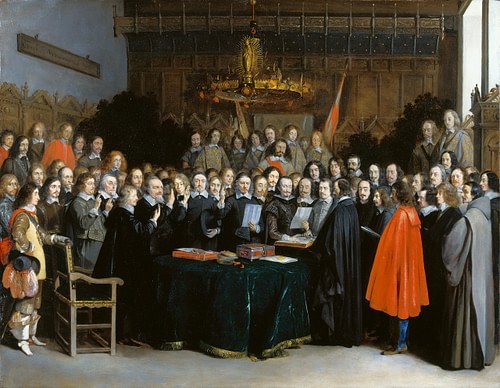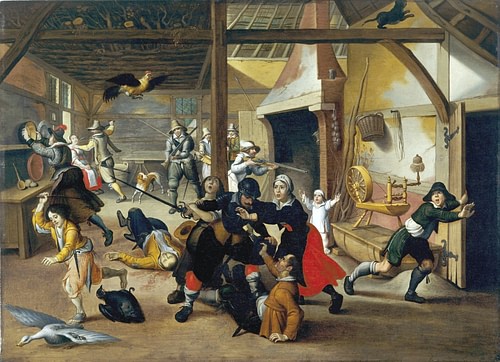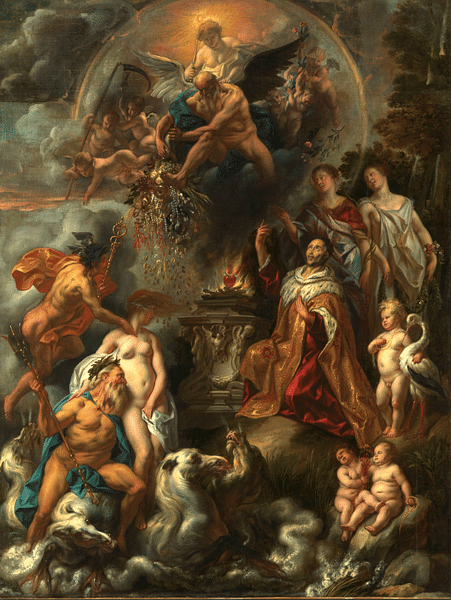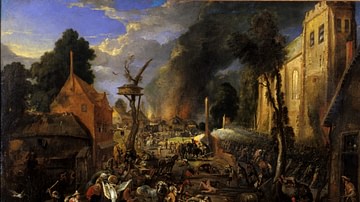
The Peace of Westphalia, the name given to the multiple treaties, marked the conclusion of the Thirty Years' War. Signed on 24 October 1648, it aimed to secure political autonomy for the multitude of small states that made up the Holy Roman Empire, allowing religious freedoms across the divided realm.
The peace also gave rise to the political concept known as Westphalian sovereignty, which declares that states, regardless of size, have the right to self-governance – a concept that still exists within the systems of international relations today.
Prelude to War
While many Christian states in Europe were relatively homogenous entities, subservient to the seat of power in their respective capitals, the Holy Roman Empire could more accurately be described as a collection of states and kingdoms of varying sizes unified under the authority of a single emperor, whilst being largely distinct from one another. This decentralised model allowed for considerable autonomy for the individual states, allowing significant political and diplomatic freedoms whilst still, in theory, maintaining allegiance to the Holy Roman Emperor. At the same time, the freedoms of the constituent states allowed them to exercise levels of autonomy regarding religion.
The question of religious freedoms in particular began to strain the political cohesion of the empire. Following Martin Luther's 95 Theses and the start of the Protestant Reformation in 1517, the Holy Roman Empire gradually became divided over which form of Christianity was seen as legitimate, with the emperor and his allies championing the established Roman Catholic tradition, whilst the Schmalkaldic League (established on 27 February 1531) embraced the new Protestant Lutheran tradition. This division inevitably led to conflict between the two factions, culminating in two wars known as the First (1546-1547) and Second (1552) Schmalkaldic Wars. These conflicts officially ended in 1555 at the Peace of Augsburg, which split the Holy Roman states between Catholicism and Lutheranism and allowed the ruler of each state within the empire to choose their religious preference. The peace, however, was far from perfect, and tensions between the two groups continued to grow, eventually coming to a head as Europe entered the 17th century.
In 1608, one of the Holy Roman Empire's most important governmental bodies, the Imperial Diet, was called, and the most pressing matter was that of the Peace of Augsburg. Between the signing of the Augsburg treaty in 1555 and the diet, the Protestant states of the empire had greatly increased their power. Many more states had converted to Protestantism, and the new Protestant leaders had begun to seize land formerly owned by the Catholic Church. The Peace of Augsburg stated that Protestant monarchs who had converted prior to 1552 and who had incorporated seized Catholic assets by that date were permitted to keep them, whereas any monarch who converted to Protestantism after 1555 would not be permitted to incorporate any Catholic assets they had seized into their own territorial churches.

The treaty, however, was purposefully vague, and both the Catholics and Protestants interpreted the limitations of the treaty differently. Despite the supposed limitations, Protestants continued to expand their influence within the religious institutions of the empire well after 1555. By the Imperial Diet of 1608, the expansion of Protestant influence had become a pressing issue, and so debate around the Peace of Augsburg was at the forefront of the gathering. The Protestant leaders had come to the diet calling for a renewal of the 1555 treaty. Fearing the Protestants would continue to use the treaty to strengthen their position, Archduke Ferdinand of Austria, who had led the premier Catholic state in the Empire, agreed they would renew the treaty, but only if the Protestants agreed to return all Catholic land taken since 1552. The Protestant delegates were expectedly furious at the suggestion and left the diet in protest. In reaction to the hostile end to the Imperial Diet, the Empire was effectively split into two factions: The Protestant Union, founded in 1608 by Frederick IV of the Palatinate, and the Catholic League, founded the following year by Maximillian I, the Duke of Bavaria.
The War of the Jülich Succession & the Thirty Years' War
The division between the Protestant Union and the Catholic League greatly destabilised the Holy Roman Empire. In 1609, following the death of John William, the Duke of Jülich-Cleves-Burg, a crisis of succession appeared within the German duchy. The complexities of Holy Roman politics meant several German nobles had legitimate claims to the duchy. To add further complexity, the claimants were divided by religious differences, with Archduke Leopold V representing the Catholic faction, and Johann Sigismund and Wolfgang Wilhelm both representing the Protestant faction. This religious divide in claimants, as well as the political opportunities such instability brings, began to attract attention from both states within the Holy Roman Empire as well as foreign powers.
Over the course of the War of the Jülich Succession (1609-1614), the duchy became the battlefield for a wider proxy war between not only the Protestant Union and the wider Catholic states but also involved the Spanish Empire, France, England, and the Dutch Republic, who all sought to exploit the conflict for their own political gains. The Protestant faction would go on to win the war, ultimately choosing to divide the duchy between the two claimants. The expansion of the war from a small succession crisis to a war involving the major European powers only served to deepen divides between the two religious groups of the empire and set the stage for what would become one of the most destructive wars in European history.

The chaos brought about by the War of the Jülich Succession showed how vital a clear line of succession was to the nobility of the Holy Roman Empire. This need for a clear successor was particularly important for the emperor. Matthias, Holy Roman Emperor (r. 1612-1619) had failed to produce any direct heirs, and so an heir needed to be chosen who could continue the Habsburgs' domination. After a period of intense diplomatic negotiations, the emperor settled on Archduke Ferdinand of Austria as his heir.
Archduke Ferdinand was already a controversial figure in the empire, especially in the eyes of the growing Protestant population. The future Ferdinand II, Holy Roman Emperor (r. 1619-1637) was a major figure in the Counter-Reformation, a movement that arose following the Protestant Reformation and aimed to combat the continued spread of Protestantism - not only in the Holy Roman Empire but throughout Christian Europe. Ferdinand, prior to his nomination as the future emperor, was acting ruler of the Duchy of Styria, and he implemented strong anti-Protestant policies upon his subjects. Forced conversions, exiles, and commandeering of Protestant lands were common under his rule, and this did little to ease religious tensions within the wider region. He was also responsible for the Protestant walkout at the Imperial Diet of 1608 – another reason why the Protestant population strongly distrusted the Austrian Archduke.
The Protestant worries about Ferdinand were further inflamed when Matthias decided that in order to provide stability and legitimacy during the transition of power, Ferdinand should be made heir to both the crown of the powerful Kingdom of Bohemia, as well as heir to the Hungarian crown. With the support of the Spanish king Philip III (r. 1598-1621, another of the Habsburgs, who was secretly promised land by Ferdinand in exchange for his support), Ferdinand successfully became king-elect in both kingdoms in 1617. This was a particular problem in Bohemia, where there was a significant Protestant population who feared the election of a prominent supporter of the Counter-Reformation would inevitably lead to clashes between the two Christian denominations.
In 1618, following his election, Ferdinand sent a number of Catholic dignitaries to Prague to assist in the governance of his new realm. These dignitaries were set upon by a Protestant mob, who, in protest against Ferdinand's election, threw the diplomats from the top floor of a castle tower. This became known as the Third Defenestration of Prague. This unrest quickly began to spread throughout Bohemia, and eventually the whole of the Holy Roman Empire, beginning what would come to be known as the Thirty Years' War.
The Peace of Westphalia
The Thirty Years' War, much like the War of the Jülich Succession that came before it, rapidly became a battleground not only amongst the religiously divided Holy Roman Empire but also among many of the European Great Powers, who saw the war as an opportunity to further their own interests and strengthen their own positions. The Thirty Years' War brought with it the intervention of several other European states, including the Spanish, the Dutch, the French, and the Scandinavian states of Sweden and Denmark-Norway. The scale of the war, which was primarily fought within the borders of the Holy Roman Empire, led to one of the most violent and costly conflicts in European history. By the end of the conflict, an estimated 8 million people had been killed due to fighting, disease, and starvation, with the majority of those killed being civilians. As the war progressed, costs – both financial and human – began to grow, and the need for peace between the warring nations became obvious.
The first major move towards peace was the 1635 Peace of Prague. By the 1630s, Emperor Ferdinand's priority was securing general peace between the Catholic and Protestant states within the empire itself. This included the Protestant states that had allied themselves with Sweden, which had invaded the empire on the side of the Protestants in 1630. Ferdinand hoped that peace within the empire would allow the people to unite and focus on driving the numerous foreign powers out of the Holy Roman Empire. In order to achieve this, Ferdinand was willing to rescind elements of the Edict of Restitution, an edict passed in 1629, which proclaimed land taken from the Catholics had to be returned in accordance with the territorial situation outlined in the 1555 Peace of Augsburg.
Diplomatic talks were focused primarily on two states: Catholic Bavaria and Protestant Saxony. For Bavaria, Ferdinand promised that Maximillian, Elector of Bavaria, would retain command of Bavarian troops within the new united German-speaking army Ferdinand was attempting to create. This, alongside a marriage between Maria Anna, Ferdinand's eldest daughter, and Maximillian, solidified Bavarian support for the peace. For the Saxons, their agreement was secured by dissolving the Catholic League, as well as ensuring the Edict of Restitution was rescinded as Ferdinand had promised. An amnesty for any state that had taken up arms against the emperor after 1630 was also enacted. After these talks, the terms of the peace were agreed, and on 30 March 1635, Emperor Ferdinand and John George I, Elector of Saxony signed the Peace of Prague. Although Saxony was the only official signatory (other than the emperor), other states were invited to join soon after. The Peace of Prague is commonly cited as the end of the religious aspect of the war, with the remainder of the conflict primarily being fought over foreign powers' geopolitical interests in the empire.
Although the Peace of Prague marked an important milestone in the eventual conclusion of the conflict, the war would continue for another 13 years before peace was fully achieved. Although small, preliminary peace agreements had been discussed between the Great Powers, it was not until 1646 that serious peace talks between the empire and the other European states took place. Ferdinand II, who had been the Holy Roman Empire's ruler for much of the conflict, had died in 1637, and so it was left to his son Emperor Ferdinand III, Holy Roman Emperor (r. 1637-1657) to lead the peace negotiations. Delegates from across the major European powers were invited to the German province of Westphalia, where two venues were chosen to hold the peace talks: the cities of Münster and Osnabrück. These two cities would lend their names to the two separate peace treaties that make up the combined Peace of Westphalia.

The negotiations that took place in Westphalia were notoriously complex, as each participant had their own ideas of what peace in Europe would look like. The talks were further complicated as the negotiations also hoped to secure a separate peace between the Dutch and the Spanish, who themselves were fighting a separate war, known as the Eighty Years' War, which had become intertwined with the Thirty Years' War once the two states sought to intervene in Holy Roman affairs.
The Peace of Münster, as it came to be known, was the first success of the peace negotiations. On 30 January 1648, the Dutch Republic and the Spanish Empire agreed to terms, with the Spanish officially recognising Dutch independence and bringing an end to eighty years of war in the Low Countries. Although not technically part of the Peace of Westphalia, it is closely interlinked and marks the first success of the Westphalian peace talks. Although a major success, the Peace of Münster did not address the emperor's two most pressing concerns: securing peace with Sweden and France (whilst Catholic, the French had intervened on the side of the Protestants in order to strike against their Austrian rival). Talks on securing these peace treaties were split between the two Westphalian cities, with talks at Münster focusing on peace with France and talks at Osnabrück addressing peace with Sweden. At this point in the war, the Habsburgs and their allies were losing, and so Ferdinand III had to be willing to make concessions to the French and Swedish in order to ensure a lasting peace.
On 24 October 1648, an agreement was reached, and two treaties were signed. The Treaty of Osnabrück marked the end of the war with Sweden, ceding territory on the Baltic Sea to Sweden, as well as offering payment to cover the costs of the Swedish army. The Treaty of Münster ended the war with France, ceding to them a number of cities in the Alsace region. A number of territorial changes were also made within the emperor's domains, altering the balance of power within the Holy Roman Empire.
Westphalian Sovereignty
The most consequential aspects of the peace, however, came in clauses relating to individual sovereignty within the empire. Although religion played a lesser role in the later years of the conflict, it was still one of its primary causes, and so the divide between the Catholics and Protestants within the empire had to be addressed. It was decided that the 1555 Treaty of Augsburg would be re-implemented, with a number of changes to address the problems the initial treaty failed to solve. The first change would see the Calvinists, a Protestant denomination that had gained significant popularity since 1555, included alongside Catholics and Lutherans in the aims of the treaty. A modification was also made to the treaty that required a return to the state of religious land ownership as it was on 1 January 1624. It was also no longer required that subjects follow the religion of their lord, allowing all citizens of the Holy Roman Empire to practice one of the three protected faiths freely.

The treaties also addressed the right of each of the Holy Roman states to self-governance. Following the Peace of Westphalia, each state of the empire, regardless of size or military power, was permitted to pursue its own domestic and foreign policy. As long as it was not a direct threat to the empire or the emperor, states could make alliances, conduct trade, and decide on their involvement in the empire's wars, independent of any other state. These general principles of self-governance make up the concept known as Westphalian sovereignty, which, some argue, forms the basis for the modern system of international relations. Modern historians and political scientists disagree on whether the Peace of Westphalia and the idea of Westphalian sovereignty actually solved any of the problems they intended to, as war in Europe did not end and state sovereignty was still exploited by the European Great Powers, especially those with developing colonial empires.
Despite this debate, the Peace of Westphalia unquestionably marked a significant change in European politics. The Peace brought an end to two major European wars, and the precedent set in Westphalia became the basis of many future treaties, most notably the Congress of Vienna in 1814-15 after the defeat of Napoleon Bonaparte. The Peace of Westphalia fundamentally changed the functions of international politics. Although the change was not immediate, the political structures established by the Peace of Westphalia set a precedent that still underlines at least some of the systems modern international relations operate on today.







